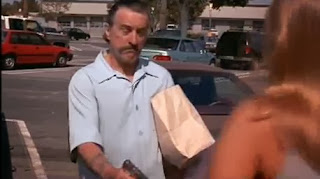Jackie Brown: generic thriller conventions
Release date: 25 December 1997 (USA)
Writers: Quentin Tarantino (screen), Elmore Leonard (novel)
Star Actresses/Actors: Pam Grier, Samuel.L.Jackson and Robert Forster.
The first action the audience see is a long tracking shot of Jackie and it is clear from her costume that she works in an airport as an air hostess. Tarantino is showing that black woman do have a high status - it looks as if he is representing her as a successful individual. The way she walks when she enters the airport shows she is confident and powerful.This shot is significant as it carries on for a long time, perhaps symbolising that she is a key character that the audience should always watch out for. Ambient lighting is shown in this first shot. Tarantino has challenged generic coventions is by casting a middle-aged black women as the protagonist.
Furthermore, whilst the audience are watching her non-digetic sound is heard where a soundtrack is played in the background. The soundtrack dominates over the character and it references soul music from the 1970'S. The soul music could also be referencing her personality. However, the lyrics in the song mentions the life of the streets - drug pushers, players, pimps.
We are introduced to another two characters called Louis and Robbie. They both appear to be scruffy characters who don't care about what others think, as Robbie's shirt is open and Louis looks scruffy in the way that he hasn't shaven his facial hair. Also Robbie is in a slouched position demonstrating that he is well laid-back and relaxed because he seems comfortable with himself. They appear to be watching a TV show which shows girls using guns, whom are wearing extremely revealing clothing. This shows their attitudes towards woman - they don't have much respect towards them. The dialogue only discusses the guns, and doesn't mention the woman, showing that violence is more appealing to them.


Melanie is later shown in this scene. We see close ups of her feet and her hand without seeing her face properly which could imply she doesn't have a high status and is less important. Alternatively, it implies that there is something mysterious about her. The rings on her toes could infer that she wants to be flashy which could mirror Robbie's personality.
After we see her, we can see she is wearing a bikini which is a vibrant colour. Tarantino may have used this to make her look attractive because the colours are visually appealing. Melanie is comfortably sitting in a chair eating, inferring that she too is lazy and tranquil.

In another scene, chiaroscuro lighting is used, which could be inspired by Film Noir. Beaumont is shown with his back up against the wall and he isn't wearing clothes. This insinuates that he has no protection from others and that he is vulnerable. Additionally, the location of the balcony is non-glamorous; it looks more gloomy, creating a dull atmosphere for the audience.

An inter textual reference for this film is the film 'Pulp Fiction' as both films have used the same low angle shot from the boot of a car. The boot could illustrate claustrophobia or entrapment. All we see is the two characters and a gun.This shot indicates mystery and suspense and represents menace. Also, the lighting here is pitch black, therefore it is non-ambient; this could symbolise fear of the unknown or death, but it mainly generates a negative vibe.

Tarantino challenges generic conventions as Louis shoots a girl (Melanie) in a car park - which is a generic thriller convention, however he shoots her in broad day light. This insinuates that he doesn't care what people think of him which could be another inter textual reference to Jason in 'Essex Boys'. Moreover, it shows that he is mad and that he is dangerous. This makes Louis seem more threatening towards the audience and other characters.

A continuing improvement in your analysis and ability to explain elements of film language whilst recognising generic conventions.
ReplyDeleteYou have illustrated your points with splendid screen shots to your well presented and organised case study.
I like the way you have recognised how specific camera shots and the location establishes Jackie as having confidence and status. I'm VERY PLEASED that you have made reference to the SOUND TRACK because this is an inter-textual reference to Blaxploitation films which Pam Greer featured in in the 1970's. You could Google "Blaxploitation films and do a little case study on the way this genre has influenced the representation of Jackie in "Jackie Brown"...no student has done this before!
You have analysed the representation of Melanie well. The angle and composition of the first shots of Melanie establish her as an "air head beach bum"!
Next Step:
In the analysis of the sequence with Ordell and Beaumont and the killing of Melanie by Ordell you needed to explain how Tarantino has either used, developed or challenged generic conventions. Of course the casting of a middle aged black woman in the leading role in a thriller is Tarantino challenging the generic archetype who plays the lead in thriller films.
Well done for making the comparison between Ordell Robbie and Jason Locke.
Keep up the good work Lauren.